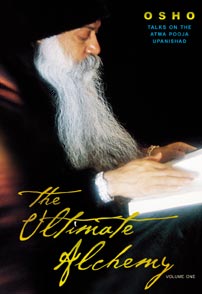Talks on the Atma Pooja Upanishad
Remain conscious of your thought process. A thought arises: know that it has arisen. A thought is there: know that the thought is there. When the thought moves and goes out of existence, then know, witness that it has disappeared. Whenever a thought goes and another thought comes, there is a gap in between. Be conscious of the gap. Remain conscious of the thought process — a thought moving, a gap, again a thought. Be conscious!
You must remain conscious
Whether you use the hara or you use breathing, you must remain conscious. Krishnamurti says, “Remain conscious of your thought process.” Whether it is the process of breathing or the palpitation of the hara or the thought process, it makes no difference. The basic thing remains the same.
Toespraken over de Atma Pooja Upanishad
Osho spreekt in The Ultimate Alchemy I over de Oosterse wijsheid, die de Atma Pooja Upanishad genoemd wordt. Zoekers naar waarheid worden uitgenodigd om dieper door te dringen  in hun diepste wezen. Zo wordt onder andere behandeld wat ‘getuige zijn’ aan bloei oplevert en van Osho’s verfijnde aroma voorzien.
in hun diepste wezen. Zo wordt onder andere behandeld wat ‘getuige zijn’ aan bloei oplevert en van Osho’s verfijnde aroma voorzien.
Ook wordt het verschil tussen wil en overgave uitgelegd.
De wijsheid van de Upanishads is niet uitvoerig, het is een intiem onderricht dat ons helpt om onszelf te transformeren.
Het boek The Ultimate Alchemy I is verkrijgbaar in de Boekhandel.
Impressie van The Ultimate Alchemy I
In this book Osho takes the Atma Pooja Upanishad, which literally means “worship of the self” and responds to it in a way that helps present-day seekers penetrate their unconscious and find the truth within themselves. This uncovering of the self is the ultimate alchemy. The Master focuses on the process of sitting, centering, witnessing, and becoming conscious.
Excerpt of the The Ultimate Alchemy I
Just Witnessing
This is a body technique. Buddha uses breathing, breath; Taoists use hara. They call the center at the navel hara. That’s why Japanese suicide is known as hara-kiri. It means committing suicide remaining centered in the hara so it is not suicide, it is not just suicide. They call it hara-kiri only if a person commits suicide remaining continuously aware of the center at the hara. Then it is not suicide at all — he is doing it so consciously. You cannot commit suicide so consciously. With you, suicide is committed only when you are so much disturbed that you have become absolutely unconscious.
Whether you use the hara or you use breathing, you must remain conscious. Krishnamurti says, “Remain conscious of your thought process.” Whether it is the process of breathing or the palpitation of the hara or the thought process, it makes no difference. The basic thing remains the same.
Remain conscious of your thought process. A thought arises: know that it has arisen. A thought is there: know that the thought is there. When the thought moves and goes out of existence, then know, witness that it has disappeared. Whenever a thought goes and another thought comes, there is a gap in between. Be conscious of the gap. Remain conscious of the thought process — a thought moving, a gap, again a thought. Be conscious!
Use thought as an object for your witnessing. It makes no difference: you can use breathing, you can use thought, you can use the HARA — you can use anything. There are many methods and each country has developed its own. And sometimes there is very much conflict about methods — but if you go deep, one thing is essential and that is witnessing — whatsoever the method may be. The difference is only of the body.
This witnessing of the thought process is as much a method as the witnessing of breathing. You can witness breathing, you can witness the thought process. And then, then you can appreciate that if someone is using a rosary, he can witness it. Then there is no difference between witnessing the movement of the rosary or witnessing breathing or the thought process.
From: The Ultimate Alchemy, vol. 1
